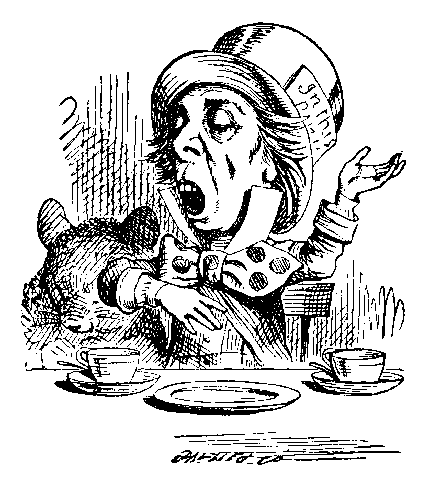We have recently discovered that we failed to note this reference to the works of John Tenniel when we first went through QU. With this addition, we have now assembled all of our QU posts into a single page so that they can be read in the order in which the art works appear in the book. We will prepare similar pages for the other volumes as we proceeed.

Mad Hatter Engaging in Rhetoric
Sir John Tenniel, 1865
Illustrations for Carroll’s Alice in Wonderland
The Project Gutenberg EBook
Jenkins describes M. Dubuisson: “His upper lip and general carriage made me think of a French version of the Mad Hatter.” [QU 114 /116]. This is the first of many references in Dance to Alice in Wonderland by Lewis Carrroll.
John Tenniel’s (1820-1914) original illustrations for Alice in Wonderland are so well-known and closely linked to the book, that that the image above of the Mad Hatter must have been what Jenkins had in mind.
Tenniel studied art at the Royal Academy and was already a famous cartoonist for Punch when Carroll approached him to illustrate Alice. Carroll initially planned to illustrate it himself, and Tenniel worked closely with him in planning the ninety-two drawings for Alice and for Through the Looking Glass, which are now among the best known book illustrations. For the book, Tenniel’s drawings were engraved on wood blocks by the Brothers Dalziel; the blocks, now at the Bodleian Library at Oxford, were masters for electrotypes in the book.
The phrase ‘mad as hatter’ was in use in the eigthteenth century, preceding Carroll’ s work. Hat makers often became psychotic because of the toxic effects of the mercury solution that they used to process fur. However, H.A. Waldron, in an essay in the British Medical Journal, argues that The Hatter’s personality was not typical of mercury toxicity and that Carroll actually based the character on an eccentric furniture dealer who always wore a top hat.
In this illustration from chapter seven, A Mad Tea-Party, The Hatter is reciting the poem parody, Twinkle, Twinkle, Little Bat. Is Jenkins referring only to M. Dubuisson’s appearance or implying that his French host was a constant source of nonsense, like The Hatter, who spouts non sequiturs and unanswerable riddles to our delight?